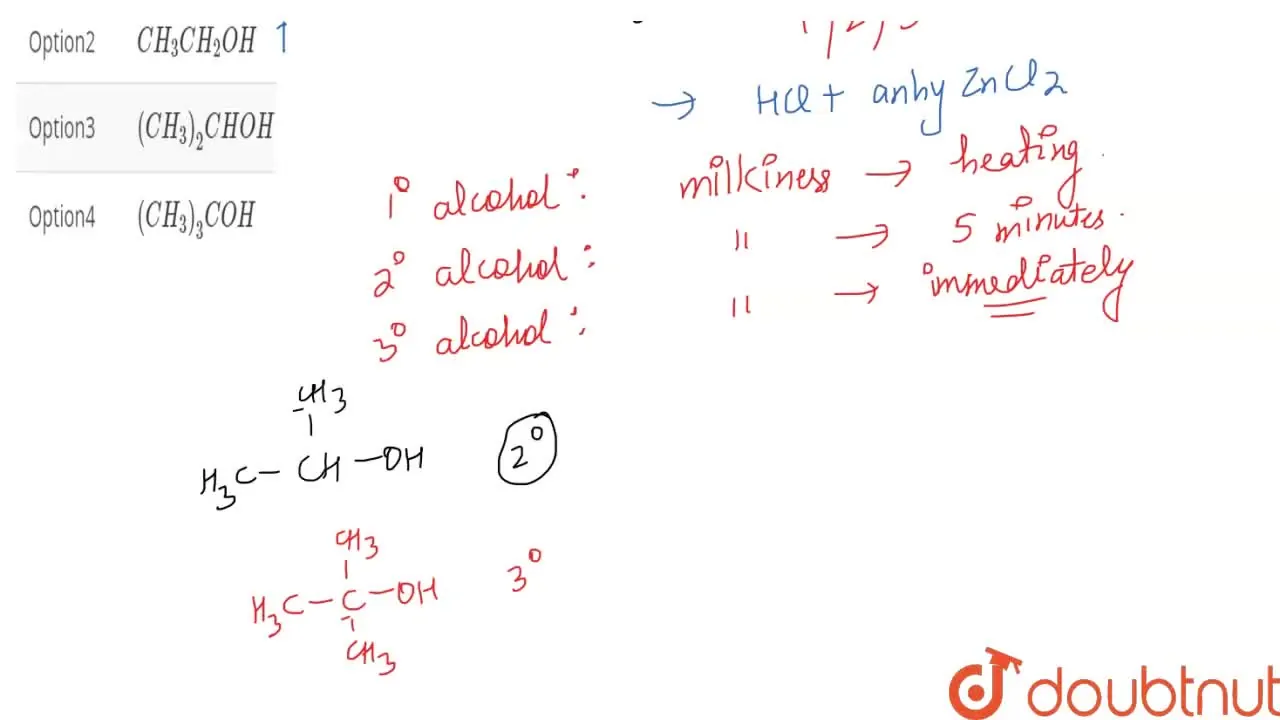Read the passage given below and answer the following questions 53-55. The electrochemical reduction of benzaldehyde and p-tolualdehyde has been achieved by diphenyl ditelluride and diphenyl diselenide as catalyst using undivided cell containing graphite (cathode) and aluminium (anode) electrodes. The products of electrochemical reduction are benzyl alcohol and p-methyl benzyl alcohol. They are characterised by by melting and boiling points. The yields of alcohol depends upon the kind of dichalcogenides compounds. The reduction is carried out in atmosphere of nitrogen. p-methyl benzaldehyde on reduction gives p-methyl benzyl alcohol.
Which alcohol will form turbidity (milkiness) with Lucas reagent immediately?
CH3OH
CH3CH2OH
(CH3)2CHOH
(CH3)3COH
Step by step video & image solution for Read the passage given below and answer the following questions 53-55. The electrochemical reduction of benzaldehyde and p-tolualdehyde has been achieved by diphenyl ditelluride and diphenyl diselenide as catalyst using undivided cell containing graphite (cathode) and aluminium (anode) electrodes. The products of electrochemical reduction are benzyl alcohol and p-methyl benzyl alcohol. They are characterised by by melting and boiling points. The yields of alcohol depends upon the kind of dichalcogenides compounds. The reduction is carried out in atmosphere of nitrogen. p-methyl benzaldehyde on reduction gives p-methyl benzyl alcohol. Which alcohol will form turbidity (milkiness) with Lucas reagent immediately? by Chemistry experts to help you in doubts & scoring excellent marks in Class 12 exams.
Related Playlists
Similar Questions
Read the passage given below and answer the following questions 53-55. The electrochemical reduction of benzaldehyde and p-tolualdehyde has been achieved by diphenyl ditelluride and diphenyl diselenide as catalyst using undivided cell containing graphite (cathode) and aluminium (anode) electrodes. The products of electrochemical reduction are benzyl alcohol and p-methyl benzyl alcohol. They are characterised by by melting and boiling points. The yields of alcohol depends upon the kind of dichalcogenides compounds. The reduction is carried out in atmosphere of nitrogen. p-methyl benzaldehyde on reduction gives p-methyl benzyl alcohol.
Correct formula of p-methyl benzyl alcohol is:View SolutionRead the passage given below and answer the following questions 53-55. The electrochemical reduction of benzaldehyde and p-tolualdehyde has been achieved by diphenyl ditelluride and diphenyl diselenide as catalyst using undivided cell containing graphite (cathode) and aluminium (anode) electrodes. The products of electrochemical reduction are benzyl alcohol and p-methyl benzyl alcohol. They are characterised by by melting and boiling points. The yields of alcohol depends upon the kind of dichalcogenides compounds. The reduction is carried out in atmosphere of nitrogen. p-methyl benzaldehyde on reduction gives p-methyl benzyl alcohol.
Identify X in the following reaction CH3−CH=CH−CHONaBH4−−−−→'X' isView SolutionPhenol and benzyl alcohol are
View SolutionO−Crsol & benzyl alcohol are
View SolutionOxidation of alcohols depends upon _____
View SolutionOxidation products of alcohols depends upon
View SolutionHow benzyl alcohol is obtained from benzyl chloride ?
View SolutionBenzaldehyde can be converted to benzyl alcohol by –
View SolutionMethyl cyanide on reduction with sodium and alcohol gives
View SolutionHow will you distinguish between benzyl alcohol and phenol ?
View Solution


